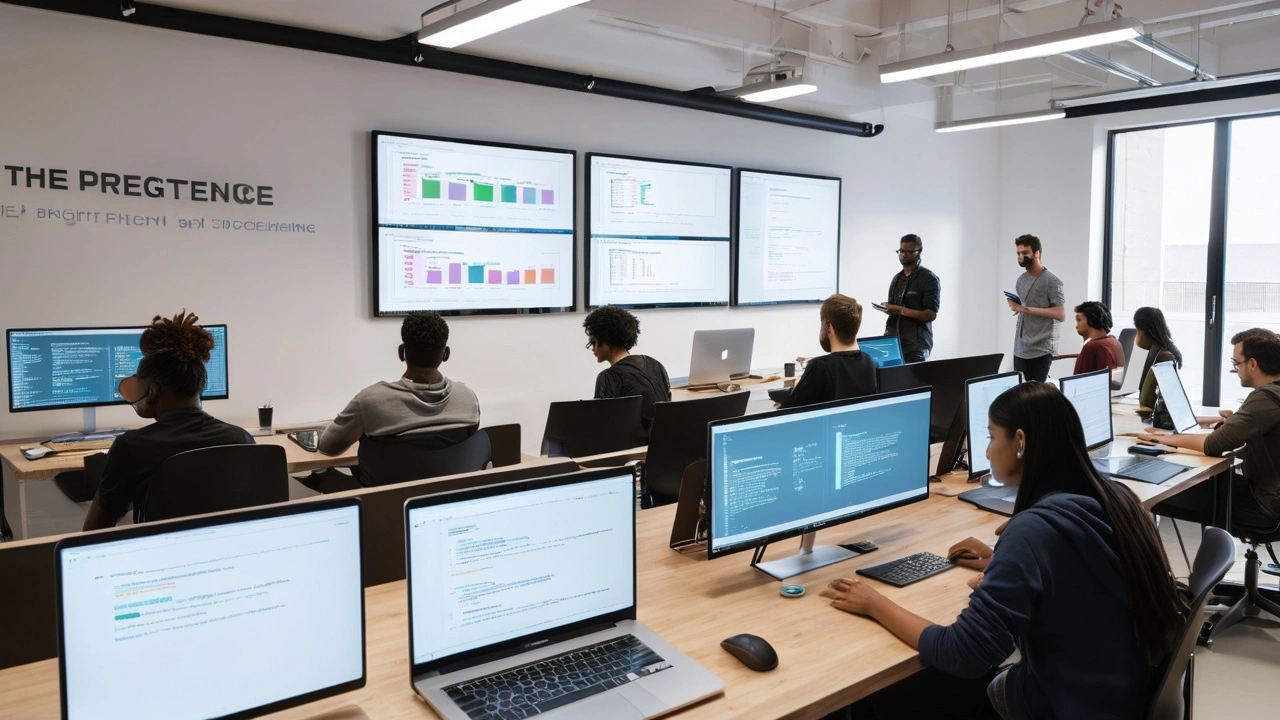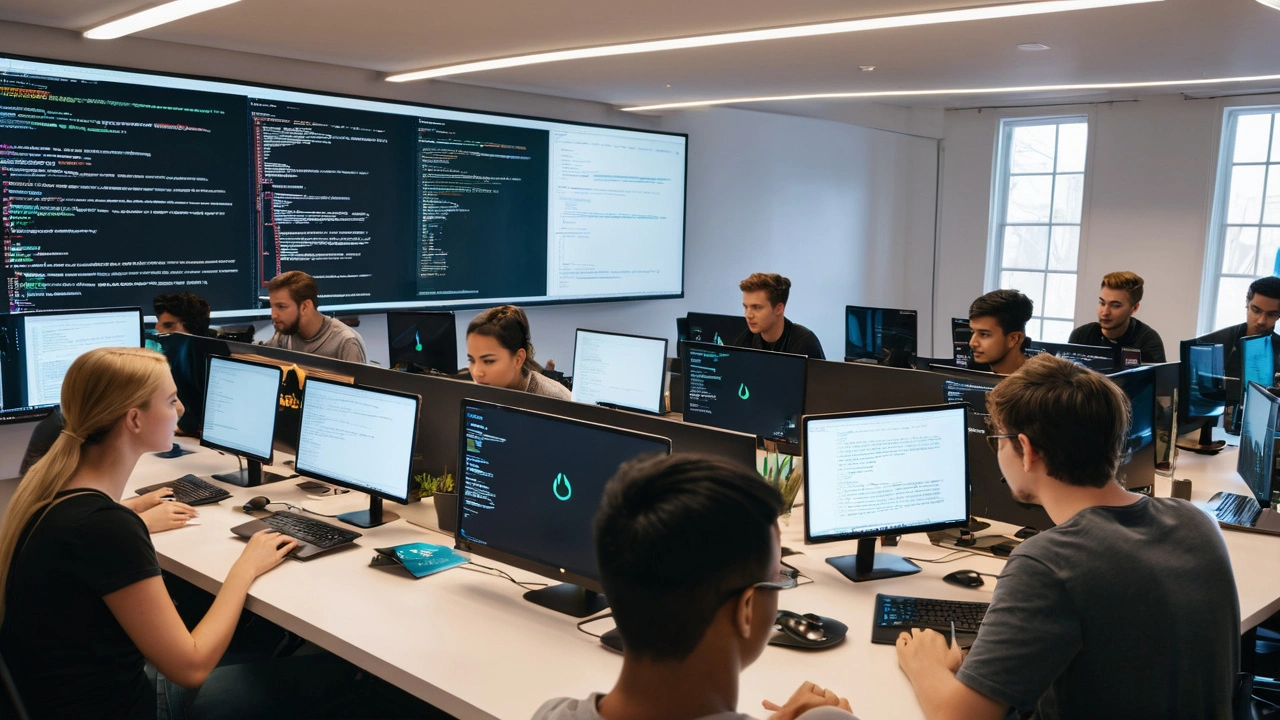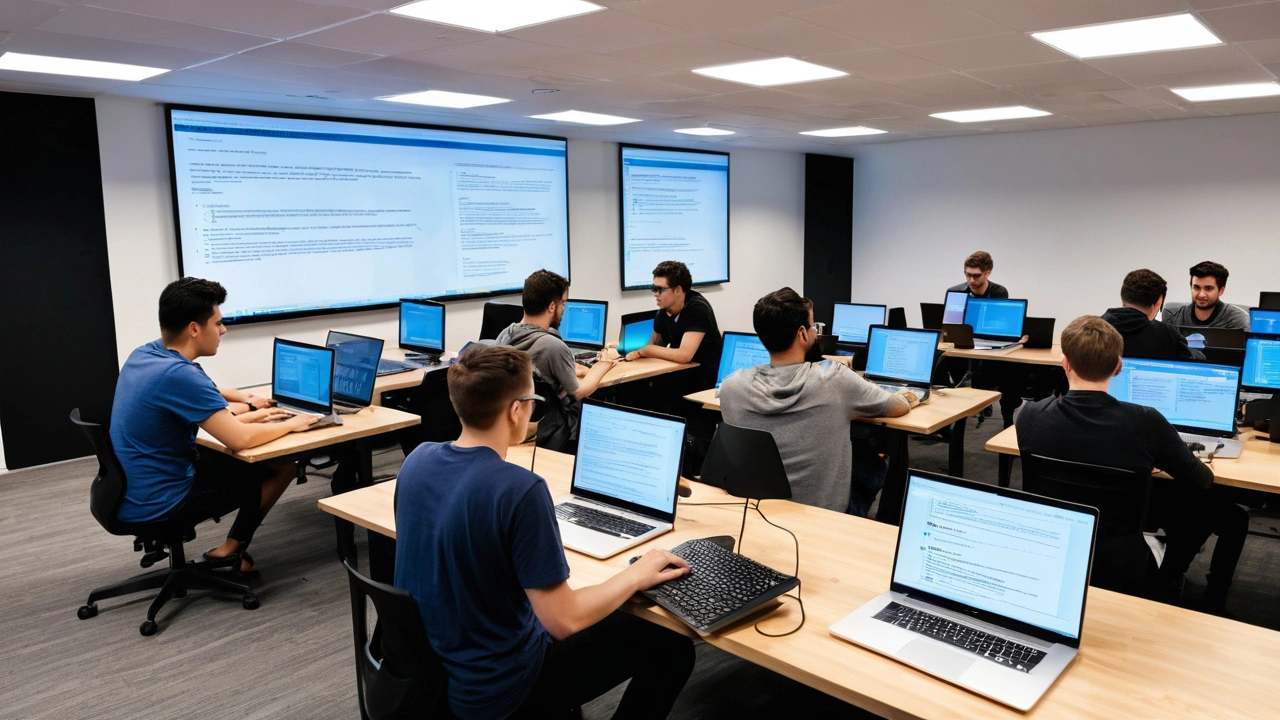Step-by-Step Guide for New Programmers

Thinking about diving into the exciting world of programming? You've come to the right place! This guide is tailored for beginners who are eager to take their first steps in coding. We'll break down the entire process into simple, understandable steps.
We're going to start by understanding the very basics, then move on to choosing the right programming language that suits your interests. Next, you'll learn how to set up your development environment, write and test your very first program, and find resources that will help you keep learning and improving.
Programming might seem intimidating at first, but with a clear path and meaningful advice, anyone can learn to code.
- Understanding the Basics
- Choosing the Right Programming Language
- Setting Up Your Development Environment
- Writing and Testing Your First Program
- Resources for Continuous Learning
Understanding the Basics
Before you dive into coding, it's crucial to understand the fundamental concepts that shape every programming language. At its core, programming is about giving instructions to a computer to perform specific tasks. This involves writing code in a language that the computer can interpret.
One of the first things to grasp is the concept of syntax. Syntax refers to the set of rules that define the combinations of symbols that are considered to be correctly structured programs in a language. Think of it as the grammar of the language you're learning. Each programming language has its own syntax, and initially, it might feel like learning a new spoken language. However, over time, you'll get the hang of it.
Another key concept is variables. Variables are used to store information that your program can use to perform operations. For example, if you're writing a program to calculate the area of a rectangle, you might have variables for the length and the width. Learning how to properly declare and use variables is a foundational skill in programming.
Next up is understanding data types. Different kinds of data are handled in various ways in programming. Common data types include integers (whole numbers), floats (numbers with decimal points), strings (text), and booleans (true/false values). Knowing how to work with these data types and when to use each is crucial for effective programming.
One cannot overlook the importance of control structures. These include loops and conditional statements which allow your program to make decisions and perform repetitive tasks. For example, a loop can be used to print numbers from 1 to 10, while a conditional statement can be used to print “Hello, World!” only if a certain condition is true.
“Learning to write programs stretches your mind and helps you think better, creating a way of thinking about things that I think is helpful in all domains.” – Bill Gates
Additionally, understanding functions is key. Functions are blocks of code designed to perform specific tasks. Once a function is defined, it can be reused throughout your program. This not only makes your code more efficient but also easier to read and maintain.
Lastly, don’t overlook the importance of debugging. Debugging is the process of finding and fixing errors or bugs in your code. Even the most experienced developers spend a significant amount of time debugging. There are various tools and techniques to help with this, including print statements, debugging software, and code reviewers.
To sum up, the basics of programming are not just about writing code but understanding how and why it works. These fundamental concepts are the building blocks for everything you will do in your coding journey.
Choosing the Right Programming Language
Picking the right programming language is a critical step in your journey as an aspiring developer. Different languages are suited to different types of projects and tasks, and your choice can shape your learning experience. The most popular choices often come down to Python, Java, JavaScript, and C++, each having their own unique strengths and uses.
Python is widely recommended for beginners. It's known for its readability and simplicity. The syntax is intuitive, which makes it an excellent starting point if you're looking to grasp the basics of programming without getting bogged down by complex code structures. Python is versatile and used in web development, data science, artificial intelligence, and more.
Java is another top choice, especially if you're interested in building enterprise-grade applications or Android apps. It's object-oriented, meaning it structures software around objects rather than actions, making programs more modular and easier to understand. Java has been around for decades, and its extensive libraries and frameworks are beneficial as they offer pre-built functionalities which speed up development time.
JavaScript is essential if you're aiming to become a web developer. It runs in the browser and is the standard language for front-end development. From website interactivity to complex web applications, JavaScript is foundational. Additionally, with frameworks like Node.js, you can also use JavaScript for back-end development, making it a full-stack solution.
Another notable mention is C++. It can be a bit challenging for beginners, but it's extremely powerful. If you aim to get into game development or systems programming, C++ might be worth the steep learning curve. It's known for its high performance and control over system resources, which is crucial for applications requiring real-time processing and complex computations.
Here's a quick comparison table to summarize:
| Language | Use Cases | Pros | Cons |
|---|---|---|---|
| Python | Web, Data Science, AI | Easy to read, versatile | Not as fast as C++ |
| Java | Enterprise, Android | Object-oriented, vast libraries | Verbose syntax |
| JavaScript | Web Development | Runs in the browser, versatile | Can be hard to debug |
| C++ | Game, Systems Programming | High performance | Complex syntax |
When choosing a language, think about your goals and what kind of projects excite you the most. Remember, learning your first language is just the beginning. Many concepts you'll learn are transferable between languages. So, dive in, explore, and don't be afraid to switch gears if one doesn't fit your style. The most important thing is to start writing code and gain practical experience.

Setting Up Your Development Environment
Before you can start coding, you'll need to set up your development environment. This is where you'll write and test your programs. The first thing you need is a computer that's suitable for development work. A lot has changed over the years. These days, even a mid-range laptop can handle most programming tasks. What you should be keen on is having enough RAM (8GB is a good start) and storage space, ideally a Solid State Drive (SSD) for faster performance.
Next, you'll need to choose an Integrated Development Environment (IDE) or a code editor. These tools make it easier to write and test code. Popular choices include Visual Studio Code, PyCharm, and Eclipse. Visual Studio Code has become a favorite among many developers because of its versatility and a vast library of extensions. To get started, download and install the IDE that fits your programming language of choice. If you're not sure which one to choose, Visual Studio Code is a safe bet for most languages.
Once you've set up your IDE, the next step is to install the necessary software and libraries. Depending on the programming language you choose, this could include everything from compilers, interpreters, libraries, or frameworks. For instance, if you're leaning towards Python, you'll need to install Python itself and possibly libraries like NumPy or pandas if you’re interested in data science. Many of these installations can be done through package managers like pip for Python or npm for JavaScript.
Version control is an essential part of modern programming, and Git is the industry standard. Git allows you to track changes, collaborate with others, and manage different versions of your project. Install Git and create an account on platforms like GitHub or GitLab. These platforms offer hosting for your repositories and include features such as issue tracking and project management tools. An interesting fact: As of 2024, GitHub hosts over 200 million repositories, a testament to its widespread use.
Setting up your development environment also involves configuring your IDE or code editor to your liking. This can include setting up themes, extensions, and keyboard shortcuts. Another important step is to configure the terminal or command prompt within your IDE. This can be extremely useful for running scripts, managing files, and executing system commands without leaving your coding environment.
It's essential to ensure your environment is secure. Keep your software up to date, use strong passwords, and consider tools like Docker for creating isolated environments to avoid conflicts. Additionally, backup your code regularly. Cloud services like Google Drive, Dropbox, or using tools like Time Machine on macOS can help you maintain up-to-date backups in case something goes wrong.
Finally, familiarize yourself with the documentation and community resources for your chosen tools and languages. Official documentation is often the best place to start. Communities like Stack Overflow are invaluable for troubleshooting and getting advice. Remember, every expert coder was once a beginner asking questions, so don't hesitate to seek help when you need it.
"The only way to learn a new programming language is by writing programs in it." - Dennis Ritchie
Setting up a development environment might seem daunting at first, but it's a critical step in your journey as a developer. Take your time, experiment with different tools and configurations, and find what works best for you. With the right setup, you'll be well on your way to becoming a proficient programmer.
Writing and Testing Your First Program
It's finally time to write your first program! This can be one of the most exciting steps in your journey as a new developer. If you've chosen a programming language you're comfortable with, the rest is all about translating your ideas into code. Let's start simple: One of the most common beginner programs is the classic 'Hello, World!'. This program is often the first because it's so straightforward, and it helps you understand the basic structure and syntax of a programming language.
For instance, if you are using Python, your 'Hello, World!' program is as simple as writing: print("Hello, World!"). To run your program, save your script with a .py extension and execute it using the Python interpreter in your command line:python yourscript.py. You'll see the output 'Hello, World!' if everything is set up correctly. Testing your program is vital. It verifies that your code runs as expected.
Let's dive a bit deeper. Understanding basic debugging is equally important. When your program doesn't run as expected, it may return errors. These are clues to what might be wrong. Read the error message carefully; it usually points to a specific line in your code. Fixing these issues step by step ensures you understand why something didn't work initially. Remember the words of Linus Torvalds:
"Debugging is twice as hard as writing the code in the first place. Therefore, if you write the code as cleverly as possible, you are, by definition, not smart enough to debug it."
Next, to advance from simple scripts to more complex programs, you can experiment with variables, loops, and functions. These are fundamental programming concepts that will help you write more intricate and functional code. For example, let's extend 'Hello, World!' into a simple program that repeats a greeting:
for i in range(5):
print("Hello, World!")When it comes to testing, beyond manually running your scripts, consider writing automated tests. Automated testing frameworks like Pytest for Python or JUnit for Java help you write tests that can be run automatically to check if your code works as expected after changes. Automated testing can catch bugs early and save a lot of time in the long run.
As you grow more comfortable, try integrating your code with version control systems like Git. This will help you keep track of changes and collaborate with others. Being able to commit your changes, create branches, and merge code is an essential skill for professional development. And don't forget, learning whether by success or failure, is progress. Each time you face an issue and overcome it, you're becoming a better programmer.
Here's a tip: Practice coding regularly. Platforms like LeetCode, HackerRank, and Codewars offer problems that can help enhance your skills. Join coding communities to learn from others and stay updated. There's always something new in the tech world, so being part of a community ensures you grow continuously.
To summarize, writing and testing your first program sets the foundation for your future coding endeavors. With each new concept mastered, you'll be equipped to tackle more complex challenges. So keep experimenting, debugging, and learning. Remember, every expert was once a beginner.

Resources for Continuous Learning
Learning to code is a journey, not a destination. After you've written your first program, the next step is to dive deeper into the ocean of knowledge available out there. Luckily, there are numerous resources designed to help you along the way, whether you're interested in web development, software engineering, or data science.
One of the first places to start is online courses. Websites like Coursera, Udemy, and edX offer a plethora of courses that cover everything from basic programming to advanced topics in various languages. Not only do they offer video lessons, but they also provide assignments and projects that are crucial for honing your skills. For those who prefer a more structured approach, enrolling in a coding bootcamp such as General Assembly or App Academy can be a game-changer.
Reading books is another excellent way to deepen your understanding. Some highly recommended titles include "Code Complete" by Steve McConnell and "Clean Code" by Robert C. Martin. These books are packed with practical advice and best practices that every programmer should know. Another advantage of books is that they often go into greater detail than many online resources.
Don't overlook the power of community and forums. Websites like Stack Overflow and Reddit are invaluable for asking questions and getting answers from experienced developers. Participate in coding communities, attend meetups or conferences, and engage with other aspiring developers on social media platforms. Networking with peers can lead to collaborations, job opportunities, and lifelong friendships.
Practicing coding regularly is arguably the most important part of becoming proficient. Websites like LeetCode, HackerRank, and Codewars offer a wide range of coding challenges that can help you practice and improve your problem-solving skills. Many developers credit daily coding challenges for their increased competency and confidence. Make it a habit to solve at least one problem a day.
Finally, keep an eye on the latest trends and updates in the tech industry. Subscribe to newsletters like "Hacker News" or "TechCrunch" to stay informed about what's new and noteworthy. The field of programming is always evolving, and staying updated can help you adapt to changes and seize new opportunities.
"Learning never exhausts the mind." - Leonardo da Vinci
By leveraging these resources, you'll be well on your way to becoming a skilled and knowledgeable developer. The key is consistency and curiosity. As you explore different areas and solve more problems, you'll find yourself becoming more confident and capable.